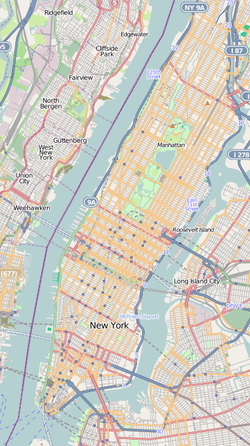
Back مبنى فلاتيرون Arabic Edificiu Flatiron AST Flatiron Building Azerbaijani Флэтайран-білдынг Byelorussian Флатайрън Билдинг Bulgarian Edifici Flatiron Catalan Flatiron Building Czech Flatiron Building Danish Flatiron Building German Edificio Flatiron Spanish
| Flatiron Building | |
|---|---|
 | |
 | |
| Former names | Fuller Building |
| General information | |
| Type | Office |
| Completed | June 1902 |
| Owner | Sorgente Group, GFP Real Estate, Newmark, ABS Real Estate,[1] The Brodsky Organization[2] |
| Height | |
| Architectural | 285 ft (86.9 m) |
| Technical details | |
| Floor count | 22 |
| Floor area | 255,000 sq ft (23,690.3 m2) |
Flatiron Building | |
New York City Landmark No. 0219
| |
| Coordinates | 40°44′28″N 73°59′23″W / 40.74111°N 73.98972°W |
| Built | 1902 |
| Built by | George A. Fuller Construction Co. |
| Architect | D. H. Burnham & Co.: |
| Architectural style | Renaissance Revival |
| NRHP reference No. | 79001603 |
| NYSRHP No. | 06101.000437 |
| NYCL No. | 0219 |
| Significant dates | |
| Added to NRHP | November 20, 1979[5] |
| Designated NHL | June 29, 1989 |
| Designated NYSRHP | June 23, 1980[4] |
| Designated NYCL | September 20, 1966 |
The Flatiron Building, originally the Fuller Building,[6] is a 22-story,[7] 285-foot-tall (86.9 m) steel-framed triangular building at 175 Fifth Avenue in the Flatiron District neighborhood of Manhattan in New York City. Designed by Daniel Burnham and Frederick P. Dinkelberg, and sometimes called, in its early days, "Burnham's Folly", it was opened in 1902.[8] The building sits on a triangular block formed by Fifth Avenue, Broadway, and East 22nd Street—where the building's 87-foot (27 m) back end is located—with East 23rd Street grazing the triangle's northern (uptown) peak. The name "Flatiron" derives from its triangular shape, which recalls that of a cast-iron clothes iron.[9][10]
The Flatiron Building was developed as the headquarters of construction firm Fuller Company, which acquired the site from the Newhouse family in May 1901. Construction proceeded rapidly, and the building opened on October 1, 1902. Originally 20 floors,[8] a "cowcatcher" retail space (a low attached building so called for its resemblance to the device on rail locomotives) and penthouse were added shortly after the building's opening. The Fuller Company sold the building in 1925 to an investment syndicate. The Equitable Life Assurance Society took over the building after a foreclosure auction in 1933 and sold it to another syndicate in 1945. Helmsley-Spear managed the building for much of the late 20th century, renovating it several times. The Newmark Group started managing the building in 1997. Ownership was divided among several companies, which started renovating the building again in 2019. Jacob Garlick agreed to acquire the Flatiron Building at an auction in early 2023, but failed to pay the required deposit, and three of the four existing ownership groups took over the building. In October 2023, the building's owners announced that it would be converted to residential condominiums; the project is planned to be complete by 2026.
The Flatiron Building's facade is divided vertically into three sections, similarly to the components of a classical column. The three-story base is clad with limestone, while the upper stories are clad with glazed terracotta. The building's steel frame, designed by structural engineering firm Purdy and Henderson, was intended to withstand four times the maximum wind force of the area. Called "one of the world's most iconic skyscrapers and a quintessential symbol of New York City",[11] the building anchors the south (downtown) end of Madison Square and the north (uptown) end of the Ladies' Mile Historic District. The neighborhood around it is called the Flatiron District after its signature, iconic building.[a] The building was designated a New York City landmark in 1966,[7] was added to the National Register of Historic Places in 1979,[12] and was designated a National Historic Landmark in 1989.[13][14] A survey in 2023 found that the Flatiron Building was the fourth-most-loved building in the United States.[15]
- ^ Cite error: The named reference
Hallum 202305was invoked but never defined (see the help page). - ^ Cite error: The named reference
Bockmann 2023 m791was invoked but never defined (see the help page). - ^ Cite error: The named reference
Alexiou pp. 47-48was invoked but never defined (see the help page). - ^ "Cultural Resource Information System (CRIS)". New York State Office of Parks, Recreation and Historic Preservation. November 7, 2014. Retrieved July 20, 2023.
- ^ "National Register Information System". National Register of Historic Places. National Park Service. January 23, 2007.
- ^ Brown, Dixon & Gillham 2014.
- ^ a b New York City Landmarks Preservation Commission; Dolkart, Andrew S.; Postal, Matthew A. (2009). Postal, Matthew A. (ed.). Guide to New York City Landmarks (4th ed.). New York: John Wiley & Sons. ISBN 978-0-470-28963-1.
- ^ a b Alexiou 2010, p. 52.
- ^ Alexiou 2010, p. 59.
- ^ Roberts 2019.
- ^ Treasures of New York City: The Flatiron Building. WLIW. 2014. Archived from the original on February 2, 2020. Retrieved April 3, 2014.
- ^ Pitts, Carolyn (February 9, 1989). "Flatiron Building". National Register of Historic Places Registration. National Park Service. Archived from the original on June 5, 2020. Retrieved March 10, 2016.
- ^ "Flatiron Building". National Historic Landmark summary listing. National Park Service. September 12, 2007. Archived from the original on March 14, 2013. Retrieved September 13, 2007.
- ^ "Flatiron Building—Accompanying Photos, Exterior, From 1979". National Register of Historic Places Inventory. National Park Service. February 9, 1989. Archived from the original on June 4, 2020. Retrieved March 10, 2016.
- ^ Cite error: The named reference
buildworldwas invoked but never defined (see the help page).
Cite error: There are <ref group=lower-alpha> tags or {{efn}} templates on this page, but the references will not show without a {{reflist|group=lower-alpha}} template or {{notelist}} template (see the help page).

